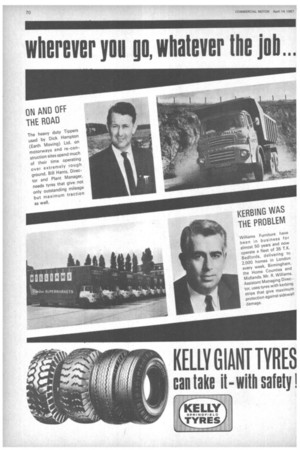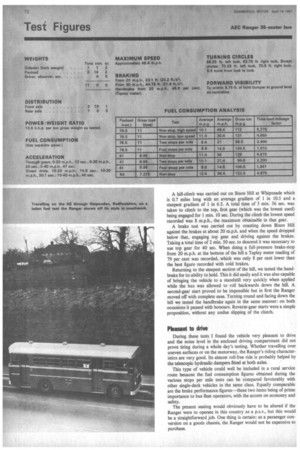wherever you go, whatever the job...
Page 72

Page 73

Page 74

If you've noticed an error in this article please click here to report it so we can fix it.
ON AND OFF THE ROAD
The heavy duty Tippers used by Dick Hampton (Earth Moving) Ltd. on motorways and re-construction sites spend much of their time operating over extremely rough ground. Bill Harris, Director and Flant Manager, needs tyres that give not only outstanding mileage but maximum traction as well.
was 8.8 m.p.g. These were the laden tests. Half-laden the fuel consumption figures were better, the two stops per mile returning 10.1 m.p.g. at an average 21.4 m.p.h. Four stops per mile was similar to the laden test, the only increase being a marginal 0.4 m.p.g.. with the average speed remaining the same.
With the vehicle unladen and cruising at 36.4 m.p.h., fuel consumption was 12.4 m.p.g. A high-speed motorway test on Ml was carried out over a measured 16 miles out and return journey and although there was a wind blowing the Ranger handled very well and the fuel consumption figures recorded were 10.1 m.p.g. for an average speed of 48.4 m.p.h.
Good acceleration Acceleratibn through the gears was better than I had expected in view of the the slow gear changes mentioned earlier: 0 to 20 m.p.h. was achieved in 10 sec., 0 to 30 m.p.h. in 20 sec. and 0 to 40 m.p.h. in 47 sec.—which are very good times considering that the Ranger is still basically a goods vehicle and not an "E"-type! No criticisms could be made of the Ranger's brake performance during all the full-pressure stops.
Braking from a speed of 20 m.p.h. produced a stopping distance of 21 ft. which is 20.2 ft. /s2 retardation and from 30 m.p.h. an average stopping distance of 44.75 ft. or 21.9 ft./ s2, the average Tapley readings for these stops being 88 per cent. The air-assisted handbrake was applied with the Ranger travelling at 20 m.p.h. and
a Tapley reading showed a figure of 46.5 per cent, the vehicle being brought to rest with no pull either way. During the foot brake tests the wheels did not lock once—which may be attributable to the anti-fade brake linings, because there was a complete lack of fade apparent when this particular test was carried out later on.
A hill-climb was carried out on Bison Hill at Whipsnade which is 0.7 miles long with an average gradient of 1 in 10.5 and a steepest gradient of 1 in 6.5. A total time of 3 min. 36 sec. was taken to climb to the top, first gear (which was the lowest used) being engaged for I min. 10 sec. During the climb the lowest speed recorded was 8 m.p.h., the maximum obtainable in that gear.
A brake test was carried out by coasting down Bison Hill against the brakes at about 20 m.p.h. and when the speed dropped below that, engaging top gear and driving against the brakes. Taking a total time of 2 min. 50 sec. to descend it was necessary to use top gear for 40 sec. When doing a full-pressure brake-stop from 20 m.p.h. at the bottom of the hill a Tapley meter reading of 79 per cent was recorded, which was only 8 per cent lower than the best figure recorded with cold brakes.
Returning to the steepest section of the hill, we tested the.handbrake for its ability to hold. This it did easily and it was also capable of bringing the vehicle to a standstill very quickly when applied while the bus was allowed to roll backwards down the hill. A second-gear start proved to be impossible but in first the Ranger moved off with complete ease. Turning round and facing down the hill we tested the handbrake again in the same manner: on both occasions it passed with honours. Reverse-gear starts were a simple proposition, without any undue slipping of the clutch.
Pleasant to drive
During these tests I found the vehicle very pleasant to drive and the noise level in the enclosed driving compartment did not prove tiring during a whole day's testing. Whether travelling over uneven surfaces or on the motorway, the Ranger's riding characteristics are very good. Its almost roll-free ride is probably helped by the telescopic hydraulic dampers fitted at both axles.
This type of vehicle could well be included in a rural service route because the fuel consumption figures obtained during the various stops per mile tests can be compared favourably with other single-deck vehicles in the same class. Equally comparable are the brake performance figures these two items being of prime importance to bus fleet operators, with the accent on economy and safety.
The present seating would obviously have to be altered if the Ranger were to operate in this country as a p.s.v., but this would be a straightforward job. One thing is certain: as a passenger conversion on a goods chassis, the Ranger would not be expensive to purchase.
























































































































